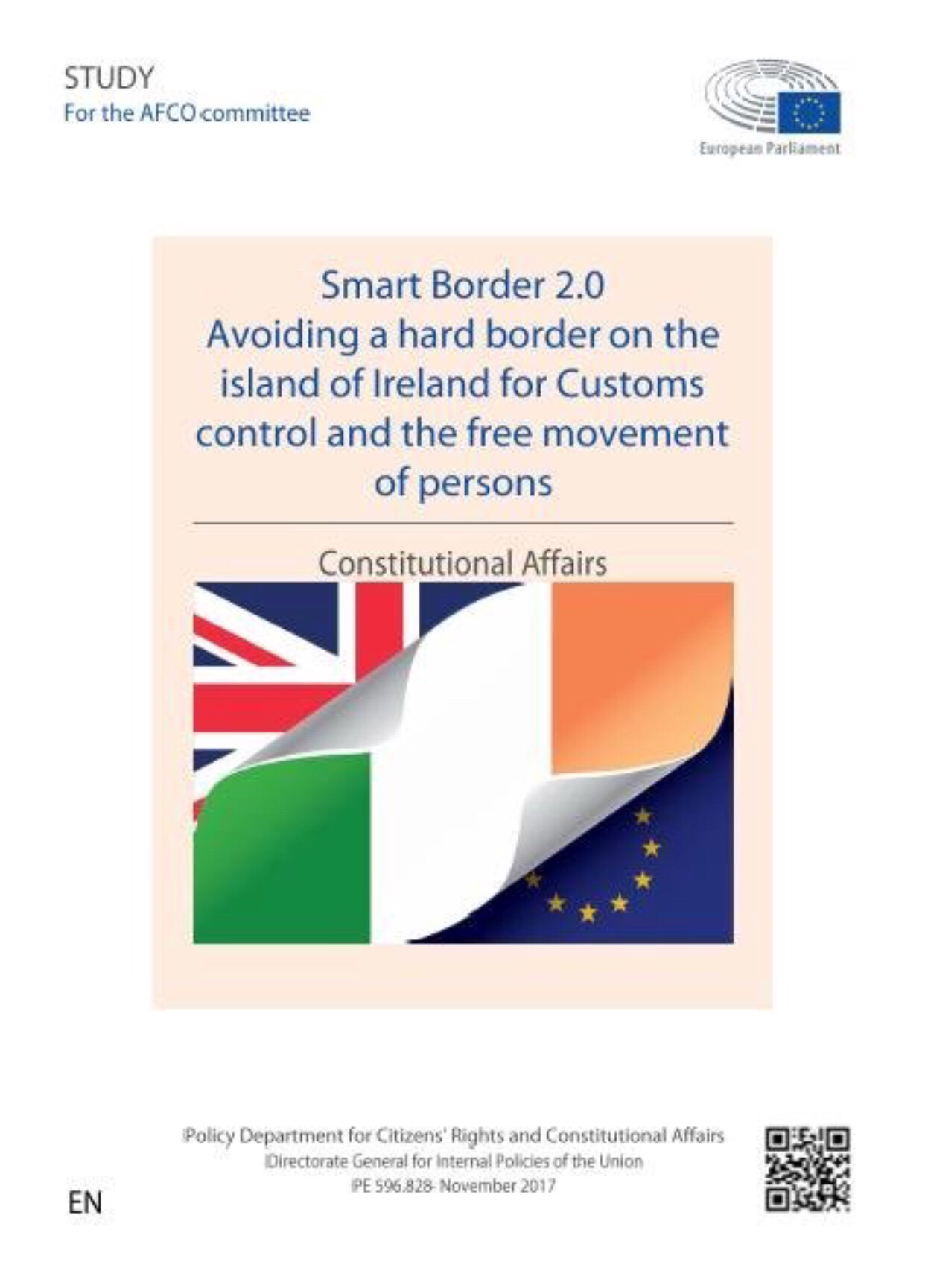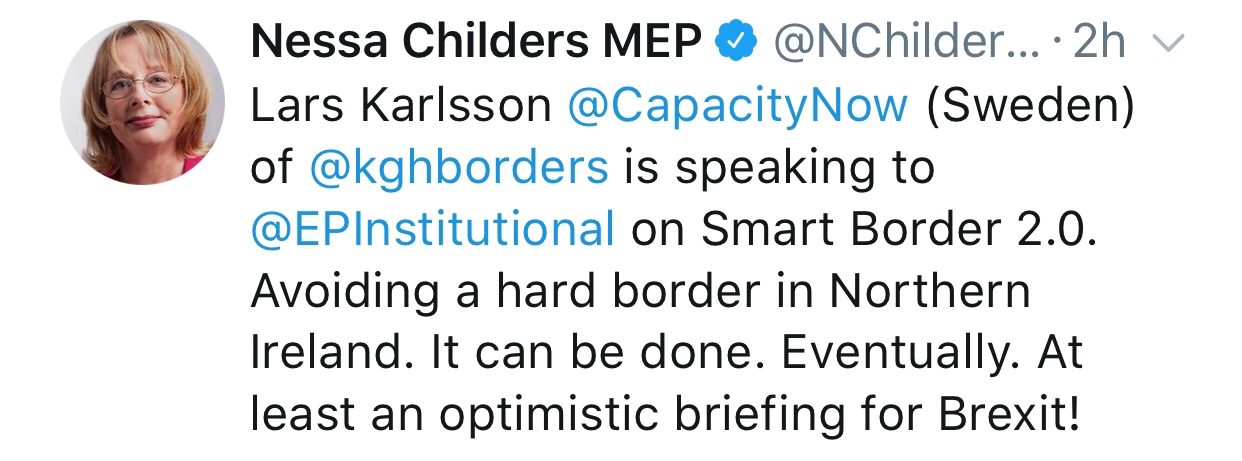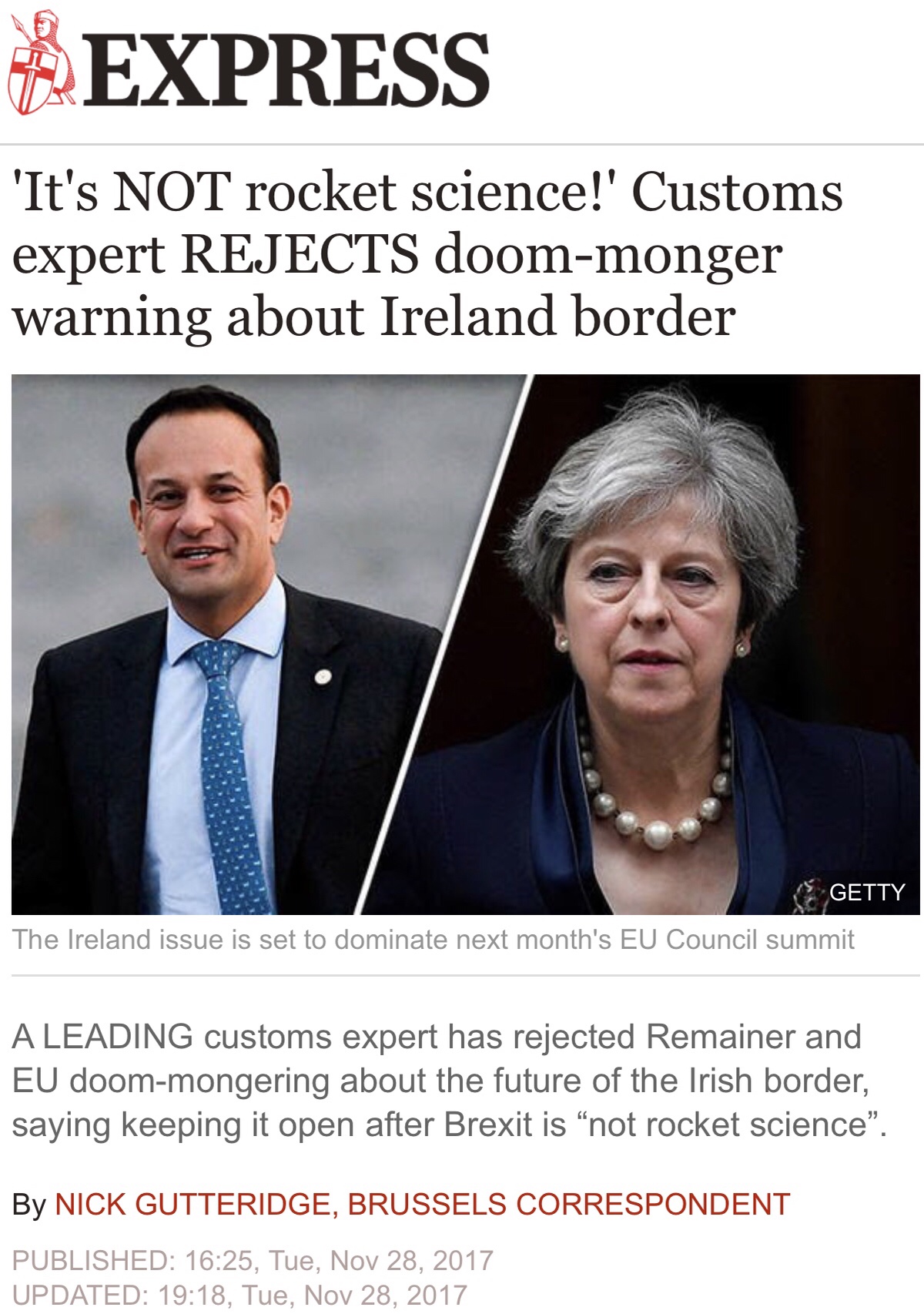SmartBorder 2.0 – A BREXIT Solution
Yesterday I presented my academic research study, ‘SmartBorder 2.0 – Avoiding a hard border on the island of Ireland for Csuustoms control and free movement of people’ to the European Parliament in Brussels.
 In the Parliment
In the Parliment
It was the EP Constitutional Committe that had commissioned a report from me and similar reports from two other researchers, Dr. John Temple Lang and the team Dr. David Phinnemore/Dr. Katy Hayward.
 My report, you can read it if you click on the link below
My report, you can read it if you click on the link below
Dr. Temple Langs report is covering ‘Brexit and Ireland – Legal, Political and Wconomic Consideration’ and Dr. Phinnemore/De. Haywards report is concentrating on ‘UK Withdrawel and the Good Friday Agreement’.
So while my fellow research colleagues did more political, policy, legal and macro-economic research, I did my study on how to actually design and construct a functional future technical Customs border management model, an ‘invisable border’.
I took a more practical approach since there have been little or no discussion so far about the technical solutions in the debate.
The idea of the SmartBorder 2.0 solution is to use international standards, operational best practices (upgraded to better practices) and stats-of-the-art technology – moving the border formalities to pre/post activities based on a new modern trusted trader/trusted traveller programme, exchange of risk data, processing in a one-stop-shop Single wlndow (utilizing UCR) and technical identification/monitoring/surveillance in combination with pre-conditioned border crossings, with no duplications and joint mobile control teams. We are not talking of massive infrastructure implementations, like houses and border crossings – but some high-tech equipment making it possible to install almost frictionless borders.
I have designed this SmartBorder 2.0 concept and we in KGH have developed operational modules that together can be used as a SmartBorder 2.0 model. This is real, not science-fiction for the future.
In fact, most of the modules we have developed in this context have also been tested or implemented in operational environments in different parts of the world. There is a need for further development, adjustment and integration – naturally – but it works.
 At the European Parliament hearing
At the European Parliament hearing
In my study I used the borders of Sweden-Norway, United States-Canada and Australia-New Zealand as examples for the model.
I was very clear at the hearing, and I want to underline it here as well – that neither of these solutions is a perfect exeample on what needs to be implemented on the Ireland-Northern Ireland border (or other borders between EU and UK). These borders are developed for other environments.
However, all these examples have Customs and border management elements and components that could be used for a SmartBorder 2.0 solution on the Ireland/NI border and other EU-UK borders. The components needs to be further developed and fully integrated to get an ‘invisable border’.
The Sweden-Norway is the most advanced border in the world from a conceptual perspective and it should in my opinion for several reasons (explained in the report) be used as basis for the new UK-EU border – but it is not perfect, and not fully utilizing all the potential of the model itself. The model and solution there can’t be directly transferred to another place. This is important to undeline. Some people misundestand that fact, deliberately or non-deliberately.
My point is that differences between the Sweden-Norway border model and new potential applications in other environments, like e.g. the Ireland-Northern Ireland example, can be mitigated by a number of development actions and new technical components, like a new trusted trader programme, a new trusted traveller scheme and different approach to security and safety.
I am talking about re-using the Customs cooperation model, the one-stop-shop, the Single Window experince, the advanced data exchange model and the operational agency model at both side of the border – just to give a few examples. There are also a number of -previously successful test pilots of even more advanced applications st the same border like e.g. The Gateway Concept and Green Corridor that easily could be adopted to work in this new context.
Naturally the Ireland-Northern Ireland border has its own challenges, history and environment, but I am convinced that it is possible to design, develop and implement a SmetBorder 2.0 solution on this border.
In addition, the Swedish-Norway border is a SmartBorder solution on an outer third country border of EU, that is already adopted, accepted, tested and operationally functional, thus very suitable to serve as example for EU-UK modelling. Especially since international institutions like the World Bank (and others) still considers it to be the fastest, safest and best border model in the world.
Some people argue that Norway has a different status in relation to EU than maybe UK will have. That is true and possible, but what is then ignored is that it has no impact on the border management model and concept since it needs to be there to handle any scenario, regardless of present or future trade policies.
 It is always interesting to have a dialogue with engaged people
It is always interesting to have a dialogue with engaged people
As I said in Brussels at the hearing, we need to acknowledge that when a country leave a Customs Union and its Customs territory, a border will be re-instated. The border is a common border and it needs to be managed, for a wide range of reasons (including tax/duty collection, security, safety, trade policy, national priorities, to regulate goods from outside both customs territories with different status etc, just to mention a few out of many). The key is to manage such a border with maximum security and minimal interference with the movement of goods and people in an interlinked and integrated economy and business environment.
The technical operational model should be negotiation neutral, meaning a solution must be able to handle any outcome of the negotitions. In addition the model needs to be scalable and to a large extent re-usable on other borders, since it is very difficult and extremely challenging to operate several different border solutions for a country (or in this case a country and another country/region/union).
Is it possible to do? Yes. Should we do it? Absolutely.
 Interesting posting from MEP on social media
Interesting posting from MEP on social media
Some people argue that the cost would be high, but I can assure you that having a detailed look at a cost-benefit calculation for the design, development and implementation of a SmartBorder 2.0 solution – in relation to the costs and consequences of NOT having such a solution in place – will be one of the best business cases ever seen.
In fact it is possible to re-use already exisiting infrastructure, like mobile networks etc for some parts of this model keeping the costs reasonable and the tecjnology isn’t that expensive any more. The options are many.
It is also interesting to note that even though my report was the only technical one leaving the political elements out of this specific study – it was still the report that attracted most political attention in media.
This was not my intention. I wanted to show that it is possible to use the knowledge, experience and technical skills we have today to create a technical border solution that can handle the situation – regardless the politics. I am naturally aware of the specific circumstances on Ireland that need to be addressed, but I want to show that there are alternatives on ghe technical level to handle different scenarios.
 Article in The Express
Article in The Express
Read the article here: The Express: “Not rocket science” sayd expert.
Read the article here: BBC on Frictionless Borders
In summary it is important to note that it has been extremely to work on this project over the last months. I have had many contacts with other Brexit experts and various professionals to develop this model and to present it in this report as a practical alternative to political debate. The proposal is based on a lifetime in this field, especially Customs and Border reform and modernization on global, regional and local level – having visited 169 countries, worked in more than 120 of these countries and seen more than 700 borders. Yes, I do count. Together with new learning and knowledge from many others, colleagues and professionals, this is my first contribution to the Brexit challange. It will not be the last.
You can find my report here, published on the EU domain: EU Parliament Constitutional Committee Lars Karlsson SmartBorder 2.0 Report Brexit

You must be logged in to post a comment.